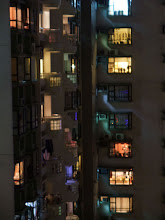The Falcon's Return by Gill Stoner raised an interesting topic. The Falcons that were endangered due to the poisoning of wildlife by our civilization-ing have been brought over to be raised in the urban jungle. Since the tall skyscrapers are just as tall (if not taller) than those of the forest (due to deforestation), the urban conditions have proved to be better and safer for these birds. (...which explains the increasing numbers of birds (hawks and eagles) that i see out of my window in Hong Kong, amongst the skyscrapers!)
The 'nature' in the city is often related to the green parks and the trees located on the side walk. However, " the urban landscaping is no more natural than urban pets, which are conditioned to sleep on couches, eat supermarket food and wear coats when it rains...the contemporary city, born of the forces of corporate capitalism, is now our own second nature." Strategies for survival has resulted in the growth of animals we consider as pests to live in the city. Rats, Pigeons, Seagulls, Cockroaches, raccoons and many more are no longer surviving in their natural habitat, but rather ours. If we disregard what we used to consider rural and urban, (wildlife versus city), the old urban has become the new 'rural', so what is the new 'urban' going to be?
If the existing conditions/ context has come into terms for a new landscape/ ground, then is the re-appropriation done Chinatown considered okay - acceptable? a decorated shed fit for advertising? would it be comparable to the 'big chicken' or 'duck house' ?
 As I walk through (the new/surviving) Chinatown in Boston (this time carefully noticing the architecture), in many sense the streets are full of advertisements! Part of a business tactic... using signs instead of the shouting ‘one dollar, one dollar.’, or having news boys shouting ‘Extra! Extra! Read all about it...’ . Signs located everywhere, added on to the facade above entrances or even protruding out perpendicular to the building. The pre-existing brick commercial buildings and low-rise row houses, has been re-imaged due to homeland nostalgia. As a method of claiming the entry to the community, archways were built despite their awkward setting/ relationships to the surrounding buildings. Despite the changing architecture, the street view of these Chinatowns are outrage and re-appropriated to distinguish familiarize themselves with the sense of home.
As I walk through (the new/surviving) Chinatown in Boston (this time carefully noticing the architecture), in many sense the streets are full of advertisements! Part of a business tactic... using signs instead of the shouting ‘one dollar, one dollar.’, or having news boys shouting ‘Extra! Extra! Read all about it...’ . Signs located everywhere, added on to the facade above entrances or even protruding out perpendicular to the building. The pre-existing brick commercial buildings and low-rise row houses, has been re-imaged due to homeland nostalgia. As a method of claiming the entry to the community, archways were built despite their awkward setting/ relationships to the surrounding buildings. Despite the changing architecture, the street view of these Chinatowns are outrage and re-appropriated to distinguish familiarize themselves with the sense of home. Today, Chinatown is a part of the varied heterogeneous American fabric in which Chinese ethnic expression is woven into the American urban scene. The building of archways no longer stand for its old meanings; rather, a commercialization tactic by the city council. This development of the Chinatowns across the world has been quite similar politically, economically and historically.
Today, Chinatown is a part of the varied heterogeneous American fabric in which Chinese ethnic expression is woven into the American urban scene. The building of archways no longer stand for its old meanings; rather, a commercialization tactic by the city council. This development of the Chinatowns across the world has been quite similar politically, economically and historically.It seems that Chinatown has become a form of parasite, that is globalized everywhere. As these Paifangs become the symbol, do they become the Starbucks sign for Chinatown? The intention of recreating the existing context to a preferred landscape that is like that of home is lost. Chinatown has now become a commodity, and a place for finding Chinese-ness, not Chinese.
What is the future of Chinatown?



No comments:
Post a Comment